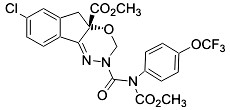Indoxacarb is an antiparasitic active ingredient used in veterinary medicine in dogs and cats against fleas. It is also used against household pests. It belongs to the chemical class of the synthetic oxadiazines.
Common name: INDOXACARB
Type: pesticide
Chemical class: oxadiazine
CHEMICAL STRUCTURE

EFFICACY AGAINST PARASITES
Type of action: Contact, non-systemic broad-spectrum insecticide.
Main veterinary parasites controlled: fleas.
Efficacy against a specific parasite depends on the delivery form and on the dose administered.
Click here for general information on features and characteristics of PARASITICIDES.
DOSING
Indoxacarb is an insecticide administered topically (spot-on) to dogs and cats against fleas. Since it is ineffective against ticks it is also used for dogs in combination with a tickicide (e.g. (e.g. permethrin). So far it is not used in livestock or horses.
The table below indicates some usual dosing recommendations for indoxacarb issued by manufacturers or documented in the scientific literature. They may not be approved in some countries.
| Dosing recommendations for INDOXACARB |
||
| Delivery | Parasites | Dose (against indoxacarb-susceptible parasites) |
| DOGS | ||
| Spot-on | Fleas | 15-62.5 mg/kg depending on animal's weight |
| CATS | ||
| Spot-on | Fleas | 25-50 mg/kg, depending on animal's weight |
DISCLAIMER: Liability is denied for any possible damage or harm to persons, animals or any other goods that could follow the transmission or use of the information, data or recommendations in this site by any site visitor or third parties.
Dosing recommendations for antiparasitics depend on national regulations. National regulatory authorities determine whether a product is approved for a given indication, i.e. use on a particular host at a specific dose and against a specific parasite. Check the labels of the products available in your country for specific information on approved indications.
SAFETY
Oral LD50, rat male, acute*: 1730 mg/kg
Oral LD50, rat female, acute*: 179 mg/kg
Dermal LD50, rat, acute*: >5000 mg/kg
* These values refer to the active ingredient. Toxicity has to be determined for each formulation as well. Formulations are usually significantly less toxic than the active ingredients.
MRL (maximum residue limit): Not applicable: not approved for livestock
Withholding periods for meat, milk, eggs: Not applicable: not approved for livestock
Learn more about indoxacarb safety (poisoning, intoxication, overdose, antidote, symptoms, etc.).
General safety information for antiparasitics is available in specific articles in this site (click to visit):
- General safety of antiparasitics for domestic animals
- General safety of antiparasitics for humans
- General safety of antiparasitics for the environment
|
WARNING Never use products for livestock on dogs and cats unless they are explicitly approved for both livestock and pets. Pets may not tolerate livestock formulations. Never use agricultural or hygiene products with this or any other active ingredient on livestock or pets, even if there are veterinary products with this same active ingredient approved for use on animals. The formulations for agricultural or hygiene use are different and may be toxic for livestock or pets. It is obvious that veterinary products are not intended for and should never be used on humans!!! |
MARKETING & USAGE
Decade of introduction: 2000
Introduced by: DuPont
Some original brands: ACTIVYL, STEWARD, AVAUNT
Patent: Expired (EU 2011; USA 2012; may have been extended. Particular formulations may be still patent-protected)
Use in LIVESTOCK: No
Use in HORSES: No
Use in DOGS and CATS: Yes, scarce
Main delivery forms:
Use in human medicine: No
Use in public/domestic hygiene: YES
Use in agriculture: YES
Generics available: Not yet...
PARASITE RESISTANCE
In pet fleas: No
In crop pests: YES
Learn more about parasite resistance and how it develops.
SPECIFIC FEATURES
Indoxacarb is a representative of the oxadiazines, a chemical class of insecticides discovered in the 1990s. It is a so-called pro-drug, i.e. it becomes toxic only after it is ingested and transformed inside the organism of selected insect species, mainly through esterase enzymes. Other parasiticides are also pro-drugs that become effective only after biological transformation, e.g. several pro-benzimidazoles (febantel, netobimin, etc.) used as anthelmintics in livestock and pets.
Efficacy of indoxacarb
For the time being the only veterinary use of indoxacarb is in dogs and cats against fleas (ACTIVYL). After topical administration to dogs or cats (spot-on - squeeze-on - pipettes) indoxacarb spreads on their hair-coat and skin and is ingested by the fleas (partially it is also absorbed through their cuticle). Indoxacarb is also absorbed through the skin of dogs and cats, but absorbed indoxacarb is not relevant for efficacy, i.e. it has not a systemic mode of action against fleas. Affected fleas stop feeding within 4 hours, stop laying eggs, and die about 24 hours after treatment.
Indoxacarb is not effective against ticks, lice, mites, mosquitoes or other external parasites of pets. To control some of these other pests in dogs, indoxacarb is also available in combination with permethrin, a veteran synthetic pyrethroids.
Pharmacokinetics of indoxacarb
After topical administration, indoxacarb remains mainly on the hair coat and skin of the treated pets. A small amount is also ingested through licking and/or grooming (particularly in cats). Absorbed indoxacarb is extensively metabolized in the liver. Excretion is mainly through the feces.
Mechanism of action of indoxacarb
Indoxacarb has a specific mode of action. It blocks the movements of sodium ions in certain nerve cells, which results in paralysis and death of the affected insects. It has been shown that this mechanism is different from the one of other pesticides that also act on sodium transport in nerve cells (e.g. synthetic pyrethroids). This means that indoxacarb has no cross-resistance with such insecticides.
Click here to view the list of all technical summaries of antiparasitic active ingredients in this site.